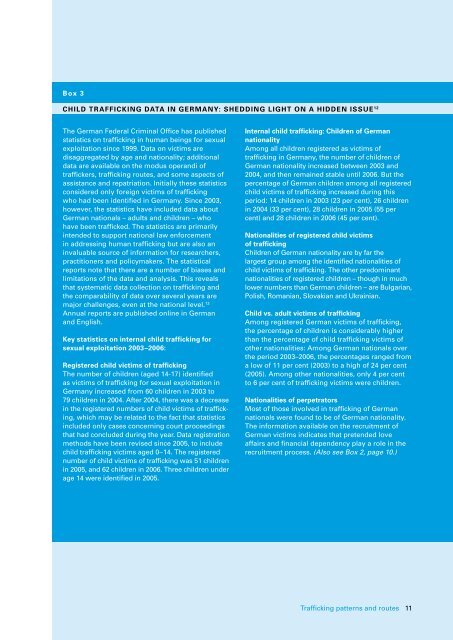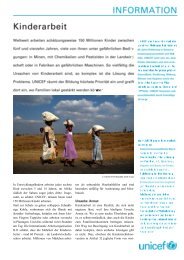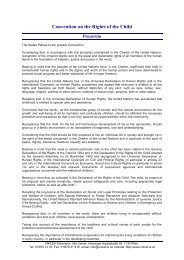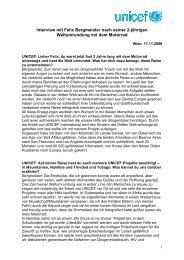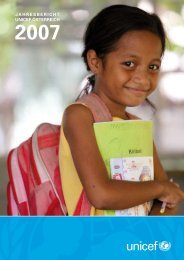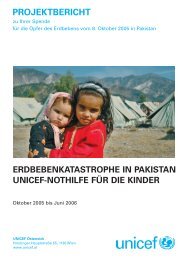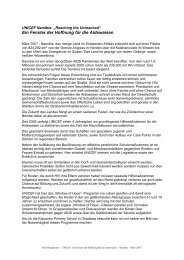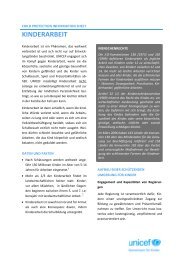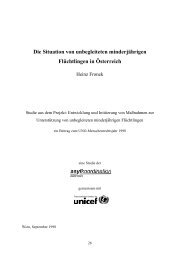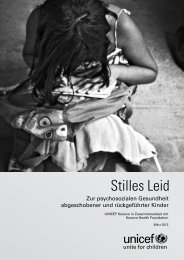Child Trafficking in Europe
Child Trafficking in Europe
Child Trafficking in Europe
You also want an ePaper? Increase the reach of your titles
YUMPU automatically turns print PDFs into web optimized ePapers that Google loves.
Box 3<br />
<strong>Child</strong> TraffiCk<strong>in</strong>g daTa <strong>in</strong> gErManY: shEdd<strong>in</strong>g lighT on a hiddEn issuE 12<br />
The German Federal Crim<strong>in</strong>al Office has published<br />
statistics on traffick<strong>in</strong>g <strong>in</strong> human be<strong>in</strong>gs for sexual<br />
exploitation s<strong>in</strong>ce 1999. Data on victims are<br />
disaggregated by age and nationality; additional<br />
data are available on the modus operandi of<br />
traffickers, traffick<strong>in</strong>g routes, and some aspects of<br />
assistance and repatriation. Initially these statistics<br />
considered only foreign victims of traffick<strong>in</strong>g<br />
who had been identified <strong>in</strong> Germany. S<strong>in</strong>ce 2003,<br />
however, the statistics have <strong>in</strong>cluded data about<br />
German nationals – adults and children – who<br />
have been trafficked. The statistics are primarily<br />
<strong>in</strong>tended to support national law enforcement<br />
<strong>in</strong> address<strong>in</strong>g human traffick<strong>in</strong>g but are also an<br />
<strong>in</strong>valuable source of <strong>in</strong>formation for researchers,<br />
practitioners and policymakers. The statistical<br />
reports note that there are a number of biases and<br />
limitations of the data and analysis. This reveals<br />
that systematic data collection on traffick<strong>in</strong>g and<br />
the comparability of data over several years are<br />
major challenges, even at the national level. 13<br />
Annual reports are published onl<strong>in</strong>e <strong>in</strong> German<br />
and English.<br />
key statistics on <strong>in</strong>ternal child traffick<strong>in</strong>g for<br />
sexual exploitation 2003−2006:<br />
registered child victims of traffick<strong>in</strong>g<br />
The number of children (aged 14-17) identified<br />
as victims of traffick<strong>in</strong>g for sexual exploitation <strong>in</strong><br />
Germany <strong>in</strong>creased from 60 children <strong>in</strong> 2003 to<br />
79 children <strong>in</strong> 2004. After 2004, there was a decrease<br />
<strong>in</strong> the registered numbers of child victims of traffick-<br />
<strong>in</strong>g, which may be related to the fact that statistics<br />
<strong>in</strong>cluded only cases concern<strong>in</strong>g court proceed<strong>in</strong>gs<br />
that had concluded dur<strong>in</strong>g the year. Data registration<br />
methods have been revised s<strong>in</strong>ce 2005, to <strong>in</strong>clude<br />
child traffick<strong>in</strong>g victims aged 0−14. The registered<br />
number of child victims of traffick<strong>in</strong>g was 51 children<br />
<strong>in</strong> 2005, and 62 children <strong>in</strong> 2006. Three children under<br />
age 14 were identified <strong>in</strong> 2005.<br />
<strong>in</strong>ternal child traffick<strong>in</strong>g: <strong>Child</strong>ren of german<br />
nationality<br />
Among all children registered as victims of<br />
traffick<strong>in</strong>g <strong>in</strong> Germany, the number of children of<br />
German nationality <strong>in</strong>creased between 2003 and<br />
2004, and then rema<strong>in</strong>ed stable until 2006. But the<br />
percentage of German children among all registered<br />
child victims of traffick<strong>in</strong>g <strong>in</strong>creased dur<strong>in</strong>g this<br />
period: 14 children <strong>in</strong> 2003 (23 per cent), 26 children<br />
<strong>in</strong> 2004 (33 per cent), 28 children <strong>in</strong> 2005 (55 per<br />
cent) and 28 children <strong>in</strong> 2006 (45 per cent).<br />
nationalities of registered child victims<br />
of traffick<strong>in</strong>g<br />
<strong>Child</strong>ren of German nationality are by far the<br />
largest group among the identified nationalities of<br />
child victims of traffick<strong>in</strong>g. The other predom<strong>in</strong>ant<br />
nationalities of registered children – though <strong>in</strong> much<br />
lower numbers than German children – are Bulgarian,<br />
Polish, Romanian, Slovakian and Ukra<strong>in</strong>ian.<br />
<strong>Child</strong> vs. adult victims of traffick<strong>in</strong>g<br />
Among registered German victims of traffick<strong>in</strong>g,<br />
the percentage of children is considerably higher<br />
than the percentage of child traffick<strong>in</strong>g victims of<br />
other nationalities: Among German nationals over<br />
the period 2003–2006, the percentages ranged from<br />
a low of 11 per cent (2003) to a high of 24 per cent<br />
(2005). Among other nationalities, only 4 per cent<br />
to 6 per cent of traffick<strong>in</strong>g victims were children.<br />
nationalities of perpetrators<br />
Most of those <strong>in</strong>volved <strong>in</strong> traffick<strong>in</strong>g of German<br />
nationals were found to be of German nationality.<br />
The <strong>in</strong>formation available on the recruitment of<br />
German victims <strong>in</strong>dicates that pretended love<br />
affairs and f<strong>in</strong>ancial dependency play a role <strong>in</strong> the<br />
recruitment process. (Also see Box 2, page 10.)<br />
<strong>Traffick<strong>in</strong>g</strong> patterns and routes 11


